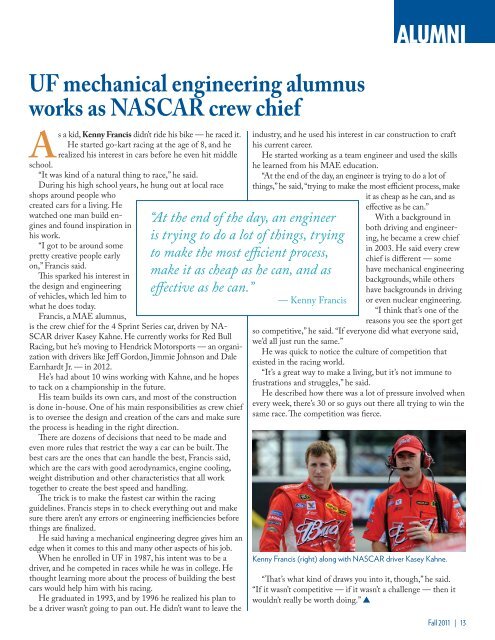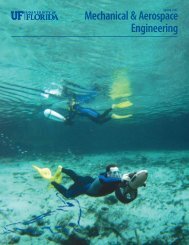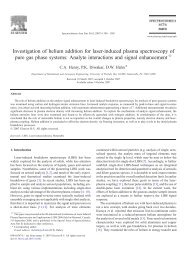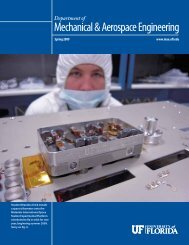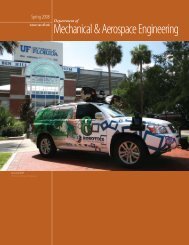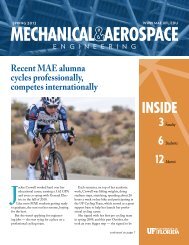here - Department of Mechanical and Aerospace Engineering ...
here - Department of Mechanical and Aerospace Engineering ...
here - Department of Mechanical and Aerospace Engineering ...
- No tags were found...
You also want an ePaper? Increase the reach of your titles
YUMPU automatically turns print PDFs into web optimized ePapers that Google loves.
ALUMNI<br />
UF mechanical engineering alumnus<br />
works as NASCAR crew chief<br />
As a kid, Kenny Francis didn’t ride his bike — he raced it.<br />
He started go-kart racing at the age <strong>of</strong> 8, <strong>and</strong> he<br />
realized his interest in cars before he even hit middle<br />
school.<br />
“It was kind <strong>of</strong> a natural thing to race,” he said.<br />
During his high school years, he hung out at local race<br />
shops around people who<br />
created cars for a living. He<br />
watched one man build engines<br />
<strong>and</strong> found inspiration in<br />
his work.<br />
“I got to be around some<br />
pretty creative people early<br />
on,” Francis said.<br />
This sparked his interest in<br />
the design <strong>and</strong> engineering<br />
<strong>of</strong> vehicles, which led him to<br />
what he does today.<br />
Francis, a MAE alumnus,<br />
is the crew chief for the 4 Sprint Series car, driven by NA-<br />
SCAR driver Kasey Kahne. He currently works for Red Bull<br />
Racing, but he’s moving to Hendrick Motorsports — an organization<br />
with drivers like Jeff Gordon, Jimmie Johnson <strong>and</strong> Dale<br />
Earnhardt Jr. — in 2012.<br />
He’s had about 10 wins working with Kahne, <strong>and</strong> he hopes<br />
to tack on a championship in the future.<br />
His team builds its own cars, <strong>and</strong> most <strong>of</strong> the construction<br />
is done in-house. One <strong>of</strong> his main responsibilities as crew chief<br />
is to oversee the design <strong>and</strong> creation <strong>of</strong> the cars <strong>and</strong> make sure<br />
the process is heading in the right direction.<br />
T<strong>here</strong> are dozens <strong>of</strong> decisions that need to be made <strong>and</strong><br />
even more rules that restrict the way a car can be built. The<br />
best cars are the ones that can h<strong>and</strong>le the best, Francis said,<br />
which are the cars with good aerodynamics, engine cooling,<br />
weight distribution <strong>and</strong> other characteristics that all work<br />
together to create the best speed <strong>and</strong> h<strong>and</strong>ling.<br />
The trick is to make the fastest car within the racing<br />
guidelines. Francis steps in to check everything out <strong>and</strong> make<br />
sure t<strong>here</strong> aren’t any errors or engineering inefficiencies before<br />
things are finalized.<br />
He said having a mechanical engineering degree gives him an<br />
edge when it comes to this <strong>and</strong> many other aspects <strong>of</strong> his job.<br />
When he enrolled in UF in 1987, his intent was to be a<br />
driver, <strong>and</strong> he competed in races while he was in college. He<br />
thought learning more about the process <strong>of</strong> building the best<br />
cars would help him with his racing.<br />
He graduated in 1993, <strong>and</strong> by 1996 he realized his plan to<br />
be a driver wasn’t going to pan out. He didn’t want to leave the<br />
“At the end <strong>of</strong> the day, an engineer<br />
is trying to do a lot <strong>of</strong> things, trying<br />
to make the most efficient process,<br />
make it as cheap as he can, <strong>and</strong> as<br />
effective as he can.”<br />
— Kenny Francis<br />
industry, <strong>and</strong> he used his interest in car construction to craft<br />
his current career.<br />
He started working as a team engineer <strong>and</strong> used the skills<br />
he learned from his MAE education.<br />
“At the end <strong>of</strong> the day, an engineer is trying to do a lot <strong>of</strong><br />
things,” he said, “trying to make the most efficient process, make<br />
it as cheap as he can, <strong>and</strong> as<br />
effective as he can.”<br />
With a background in<br />
both driving <strong>and</strong> engineering,<br />
he became a crew chief<br />
in 2003. He said every crew<br />
chief is different — some<br />
have mechanical engineering<br />
backgrounds, while others<br />
have backgrounds in driving<br />
or even nuclear engineering.<br />
“I think that’s one <strong>of</strong> the<br />
reasons you see the sport get<br />
so competitive,” he said. “If everyone did what everyone said,<br />
we’d all just run the same.”<br />
He was quick to notice the culture <strong>of</strong> competition that<br />
existed in the racing world.<br />
“It’s a great way to make a living, but it’s not immune to<br />
frustrations <strong>and</strong> struggles,” he said.<br />
He described how t<strong>here</strong> was a lot <strong>of</strong> pressure involved when<br />
every week, t<strong>here</strong>’s 30 or so guys out t<strong>here</strong> all trying to win the<br />
same race. The competition was fierce.<br />
Kenny Francis (right) along with NASCAR driver Kasey Kahne.<br />
“That’s what kind <strong>of</strong> draws you into it, though,” he said.<br />
“If it wasn’t competitive — if it wasn’t a challenge — then it<br />
wouldn’t really be worth doing.” p<br />
Fall 2011 | 13


